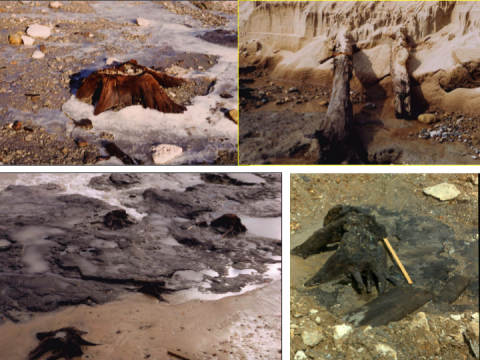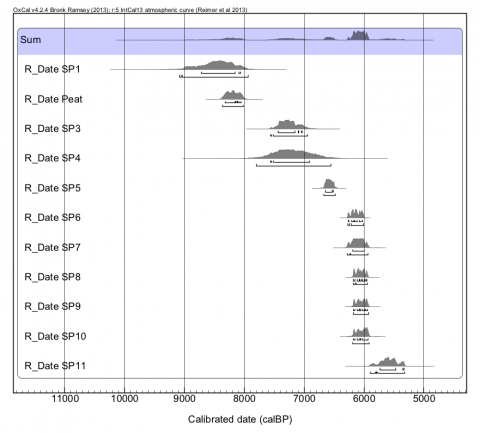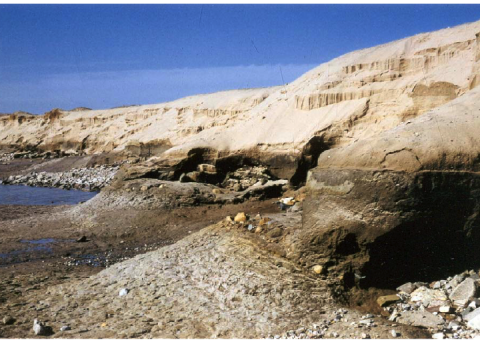• Mid Holocene lowland forest
• Nipissing transgression in the southeastern Lake Michigan Basin
This site is located along the shore of Lake Michigan in the Village of Pleasant Prairie just south of the City of Kenosha, Wisconsin. Credit for the discovery and recognition of the forest bed is given to the late Phil Sander, a local Kenosha (Wisconsin) amateur archeologist, naturalist, and historian. He first noticed “long tree roots, twelve to fifteen feet in length, extending from the base of the (sand) bluff into the lake” (Schneider et al 2009), apparently as early as the 1920s while swimming in the lake as a youngster. Through the years, he watched the site and occasionally observed logs and branches protruding from the lower part of the bluff. Then in the spring of 1961, “severe wave erosion exposed sections of entombed logs and fragments of tree branches. Visible was the forest bed and overlying lacustrine sand, which contained the buried wood, topped with layers of dune sand. In the sand bluff, numerous pieces of driftwood were visible”. A mid-Holocene buried organic layer 10 to 60 cm thick is present along the Lake Michigan shoreline in southeastern Wisconsin. Named the Southport forest bed for its location in Kenosha County, the unit has yielded abundant wood specimens, including large logs, branches, twigs, stumps, and root material. Roots of truncated in situ oak (Quercus) and elm (Ulmus) trees extend into the underlying till of the late Wisconsin Oak Creek Formation. Near shore lacustrine sand above the organic layer contains abundant driftwood, overlain by 2 to 3 m of cross-bedded dune sand. More than 50 wood samples have been identified; the assemblage is that of a mixed hardwood forest dominated by oak (Quercus) and hickory (Carya), which account for about 60% of the assemblage. Although the site has been mostly concealed for many years, it was beautifully exposed in the 1960s and early 1970s, when it was initially studied by Phil Sander, who discovered the site and documented it with field notes and numerous photographs. The peat organic is dated ca. 8,100-8,300 Cal Yrs BP, and red oak group and elm stumps to two intervals: ca. 7500-6900 Cal Yrs BP and ca. 5900-6300 Cal Yrs BP. The site is of particular importance because of its proximity to the Nipissing shoreline and provides a significant point on the Nipissing transgression time curve. The unusually large number of identified specimens affords an accurate evaluation of the warm and relatively dry climate that characterized the southern Great Lakes region during the mid-Holocene. Reference: Schneider A.F., Leavitt S.W., Lange T. 2009. Stratigraphy, age, and flora of the Southport forest bed, Southeastern Wisconsin. J. of Great lakes 35: 538-547.



